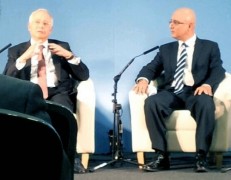
Panel discussion featuring (left) the Prime Minister of Malaysia – Najib Razak – and Jespal Deol, CEO of Graphene Nanochem.
Speaking this week at the World Islamic Economic Forum (WIEF) in London, UK, Dato’ Jespal Deol, CEO of Graphene Nanochem, which has manufacturing plants in Malaysia, described how a graphene hub could build on product success in the oil and gas industry and bring innovation to other tech sectors.
The company makes speciality chemicals and advanced nanomaterials from renewable sources including waste materials, which goes hand-in-hand with Malaysia’s focus on using agricultural biomass as a feedstock for high-value products (National Biomass Strategy 2020: New wealth creation for Malaysia’s biomass industry – PDF download).
Deol, a lawyer by training, has a methodical approach to building a business based on graphene. “You need to assure the financial community that this is a viable product,” he told the audience. “You need to demonstrate supply side capability and product know-how”.
Nanochem is Southeast Asia’s largest producer of graphene, and uses the material as an additive to prevent drilling fluid degradation at high-temperature. Back in the lab, the firm is also looking at graphene as a catalyst support, exploiting not just the material’s high-surface area, but also its electrical properties.
Deol points out that Nanochem is making graphene products and selling them to customers today, which gives it an advantage, because the firm doesn’t have to wait for applications to arrive.
But Nanochem can also use its production and characterization expertise to kick-start other sectors, and this is the idea behind the graphene hub – to provide graphene material for partners to investigate and explore.
At the moment, the hub is based at the company’s facilities, but thanks to backing from the Malaysian government it will expand to new premises with new equipment.
Top-down vision
Developing a culture that promotes creative thinking and brings together talent from industry and academia is high on the government’s agenda.
“We need to encourage them to take risks and not punish them if they fail, if they fail for the right reasons,” Malaysia’s Prime Minister, Najib Razak, commented at the meeting.
To stimulate and develop such an eco-system, the government formed Agensi Inovasi Malaysia, which hopes to inspire and produce a new generation of entrepreneurs and ensure that ideas are taken through from creation to commercialization.
Speaking to TMR+ at the event, Mark Rozario, CEO of Agensi Inovasi Malaysia, explained that their strategy focuses not just on technology, but also on education to build a workforce with the know-how that’s required to translate discoveries from the lab to the market.
Launched in 2010, Agensi Inovasi Malaysia has 10 years to achieve its mission of “wealth creation through knowledge, technology and innovation,” which links into the government’s objective of making Malaysia a high-income nation by 2020.


Pingback: Graphene supply, application and commercialization 2014 (Manchester, UK) | Graphene Stakeholders Association
Pingback: MRS Fall 2013 highlights – part two | TMR+
Pingback: Show report: Graphene supply, application and commercialization 2014 (Manchester, UK) | TMR+